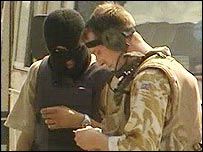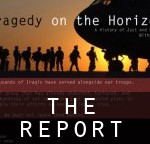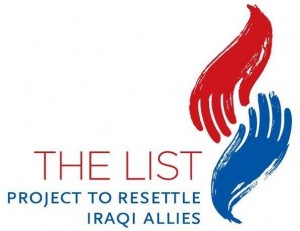Timeline of Major Events in the Iraqi Refugee Crisis and the List Project
March 2003 – George W. Bush launches the invasion of Iraq (Operation Iraqi Freedom).
January 2005 – Kirk Johnson travels to Iraq to work as an information and public affairs officer for USAID.
 September 2005 – Mr. Johnson transfers to Falluja as USAID’s first coordinator for reconstruction in the city. Ellen R. Sauerbrey is nominated to head the State Department’s nearly $1 billion per year refugee program but faces stiff opposition in Congress, where her lack of experience or expertise in the area is questioned. (Photo: Left, Ellen Sauerbrey at confirmation hearing. Source: WashingtonPost.com)
September 2005 – Mr. Johnson transfers to Falluja as USAID’s first coordinator for reconstruction in the city. Ellen R. Sauerbrey is nominated to head the State Department’s nearly $1 billion per year refugee program but faces stiff opposition in Congress, where her lack of experience or expertise in the area is questioned. (Photo: Left, Ellen Sauerbrey at confirmation hearing. Source: WashingtonPost.com)
January 2006 – While on vacation from Falluja, Kirk Johnson survives a near-death experience prompted by PTSD. He returns to the US to begin healing. Ms. Sauerbrey is appointed during a Congressional recess.
October 2006 – Y, an Iraqi colleague of Mr. Johnson’s at USAID, receives a death threat in the form of a severed dog’s head after being identified by a militia as assisting the United States. After receiving no support to speak of from the US Government, Y flees to the UAE and writes to Mr. Johnson for help.
December 2006 – The Iraq Study Group Report is released, advising that ‘The number of refugees and internally displaced persons’ is increasing dramatically. If this situation is not addressed, Iraq and the region could be further destabilized, and the humanitarian suffering could be severe. Funding for international relief efforts is insufficient, and should be increased.’ Meanwhile, Mr. Johnson writes an op-ed in the Lost Angeles Times on behalf of Y. Within days, other Iraqis who had worked with Mr. Johnson begin writing to seek his help, sharing their stories. He begins to tabulate a list.
January 2007 – George W. Bush announces plans to raise the number of US troops in Iraq by 30,000 over the course of 6 months. By this time, approximately 2 million Iraqis are already refugees in neighboring countries. Another 1.7 are internally displaced. Ms. Sauerbrey suggests that as many as 20,000 could be admitted to the United States in fiscal year 2007.
February 2007 – Mr. Johnson brings his list to the State Department in Washington for the first time, passing them the names of nearly every Iraqi who had worked with him at USAID in 2005 and who were now refugees. The State Department announces plans to allow 7,000 (not 20,000) Iraqi Refugees into the U.S. in fiscal year 2007 and creates an Iraq Refugee Inter-agency Taskforce, headed by Under-Secretary of State. She is charged with cutting through bureaucratic inertia and saving the lives of more Iraqis.
March 2007 – The New Yorker’s George Packer publishes ‘Betrayed‘, a powerful story that exposes how dire the situation is for Iraqis who worked for the US. The List is featured in that piece. The List is also mentioned in a congressional hearing on the issue.
April 2007 – Holland & Knight LLP teams up with The List Project, assuming the legal services caseload for all of the Iraqis on the List who are outside Iraq’s borders. Chris Nugent heads up Holland & Knight’s team of lawyers who begin to contribute thousands of hours of pro bono counsel to Iraqis on the List. Mr. Johnson writes a New York Times op-ed calling attention to the material support bar which denies US entry to endangered Iraqis because they paid ransoms to insurgents to free imprisoned family members. Ms. Sauerbrey off-handedly suggests that the US could accept as many as 25,000 Iraqi refugees within the year. Hope ignites fleetingly within the refugee community before the comment is downplayed by the State Department.
May 2007 – The List grows to 300+ names.
June 2007 – Proskauer Rose LLP joins The List Project, assuming the legal services caseload for the Iraqis on the List who are still trapped inside Iraq’s borders. Eric Blinderman, a former Counsel to the Coalition Provisional Authority and Regime Crimes Liaison Office in Iraq, heads up Proskauer’s pro bono commitment. The List Project is formally launched on June 20th, World Refugee Day. Senators Edward Kennedy (D-MA), Gordon Smith (R-OR), Joe Biden (D-DL), Chuck Hagel (R-NE), Patrick Leahy (D-VT), Carl Levin (D-MI) and Joe Lieberman (I-CT) introduce the ‘Refugee Crisis in Iraq Act‘, which attempts to prod the resettlement bureaucracies in the absence of any demonstrable commitment from President Bush.
July 2007 – ABC World News airs a segment on TLP in which Ms. Sauerbrey pleads ignorance of the List, despite Mr. Johnson’s numerous communications with her bureau. Meanwhile, Sweden, an opponent of the invasion of Iraq and not a member of the US-led coalition, takes in over 18,000 Iraqi refugees, making it the world’s leader in providing a safe-haven to Iraqis. Coalition member Denmark airlifts 370 Iraqis who assisted the Danish civil and military forces in Iraq. Total number of Iraqi refugees accepted by the United States from the beginning of fiscal year 2007 to the end of July: 133
August 2007 – Y, the first member of the List (and the subject of the LAT op-ed) is resettled with his wife to the US to live with Mr. Johnson’s family in Illinois. Upwardly Global, an NGO committed to helping refugees find meaningful employment in the U.S., partners with TLP to assist Iraqis on the List.
September 2007 – After a surge in admissions during the final two months of fiscal year 2007, the US ultimately admits just 1,608 Iraqi refugees by month’s end, woefully short of its promised 7,000. In response, the State Department vows to admit 12,000 Iraqi refugees in fiscal year 2008. On September 19th, the Administration appoints coordinators at the Departments of State and Homeland Security, Ambassador James B. Foley and immigration law expert Lori Scialabba, to replace the Iraq Refugee Inter-agency Task Force created seven months earlier. Their assignment – to speed up the process of resettling Iraqi refugees – is precisely the same as their predecessor’s. The bureaucratic circle begins anew. The Kennedy-Gordon legislation on Iraqi refugees passes the Senate with strong bipartisan support, but the White House remains silent on the topic.
December 2007 – The List hits 700 and we welcomed 24 arrivals. Ms. Sauerbrey announces her resignation on December 21.
January 2008 – President Bush signs the Refugee Crisis in Iraq Act into law. Mr. Johnson travels to Jordan to meet with members of the List who are struggling to survive in the face of bureaucratic delays, dwindling financial resources, and expired visas.
February 2008 – The List grows to 900. George Packer’s ‘Betrayed’ debuts as a play at Culture Project in downtown Manhattan to rave reviews. President Bush signs the Defense Authorization Act, which includes bipartisan provisions sponsored by Senators Edward Kennedy (D-MA), Gordon Smith (R-OR), Carl Levin (D-MI), and Sam Brownback (R-KS) to ease the asylum application process for Iraqi allies. US reports 1,324 Iraqi refugee admissions for first four months of fiscal year 2008.
 March 2008 – Britain, the second-largest member of the coalition forces after the United States, announces its plan to begin a major airlift of its Iraqi employees. 100 British-affiliated Iraqis will be airlifted every two weeks in RAF transport planes to the UK where they will be processed in safety. (Photo, right: An Iraqi translator, hiding his own identity, assists a British soldier. Source: BBC.com)
March 2008 – Britain, the second-largest member of the coalition forces after the United States, announces its plan to begin a major airlift of its Iraqi employees. 100 British-affiliated Iraqis will be airlifted every two weeks in RAF transport planes to the UK where they will be processed in safety. (Photo, right: An Iraqi translator, hiding his own identity, assists a British soldier. Source: BBC.com)
April 2008 – The List Project formally launches a new partnership with Mayer Brown LLP to accommodate ever-growing List. Marcia Maack, the Assistant Director of Pro Bono Activities at Mayer Brown, heads up the firm’s pro bono commitment. The List approaches nearly 1000 names.
 May 2008: 60 Minutes profiles the List Project.
May 2008: 60 Minutes profiles the List Project.
June 2008: President Bush signed into law that the special immigrant visa program would increase to allow 5000 Iraqis into the U.S. each year for the next five years. The increase in the special visa program falls under the Refugee Crisis in Iraq Act, which became law in January 2008.
July 2008: International Crisis Group and Amnesty International release reports highlighting the struggles faced by Iraqi refugees and criticizing the international response, especially the response of the U.S.
August 2008: PBS presents a documentary series on Wide Angle, entitled “Iraqi Exodus”; which documents the struggles faced by Iraqi refugees in the region.
September 2008: The U.S. announces that it surpassed its goal of admitting 12000 Iraqi refugees for fiscal year 2008 and that it would aim to admit 17000 Iraqi refugees in fiscal year 2009. Unfortunately, only 600 Iraqi Allies were processed through the special immigrant visa program, and news emerged that new Iraqi applicants faced up to a year wait before the process would begin.
November 2008: Senator Barack Obama was elected as the forty-forth President. President-elect Obama reiterates remarks made on the campaign trail that the U.S. has a moral responsibility to help with the Iraqi refugee crisis.
December 2008: The Iraqi Parliament adopts the Status of Forces Agreement in Iraq (SOFA), which specifies a timetable for US Military withdrawal by 2011. Nearly 250 Iraqis from the List have made it to America by this point.
January 2009: George Packer’s play “Betrayed” runs for one night in Washington D.C. at the Kennedy Center in an event for Refugees International. The Center for American Progress releases its plan, “Operation Safe Haven Iraq 2009,” which draws from its cooperation with the List Project. Its principal recommendation calls for a Presidential-ordered airlift of U.S.-affiliated Iraqis to a military base such as Guam for expedited processing. The List Project announces the development of a coalition letter to President Obama, backing the recommendations in the CAP plan and calling for a “Guam Option.”
February 2009: The List Project initiates its monthly e-brief series to keep our followers up to date with TLP’s mission
May 2009: Human Rights First releases a report detailing progress being made with regard to Iraqi refugees. Entitled “Promises to the Persecuted, it also details some of the remaining problems preventing Iraqis from resettling, including ongoing troubles with the bureaucratic system and time consuming security checks.
June 2009: The International Rescue Committee released “Iraqi Refugees in the United States: In Dire Straits”, a follow-up on the IRC Commission’s report in March 2008, “Five Years Later, A Hidden Crisis“, which evaluates how resettled Iraqis are adjusting to their new lives in America. The report stated that the U.S. Refugee Admissions Program is “outdated and under-funded”. The IRC Commission delegations traveled to Atlanta and Phoenix and found that while many Iraqi refugees expressed “deep gratitude for their safety and freedom in the U.S.,” they were anxious about their future and many have been unable to find work The report concluded that the U.S. resettlement program is “dangerously” underfunded and that the current economic climate has highlighted the faults in the system.
August 2009: The List Project’s Founder and Executive Director, Kirk Johnson, travels with Principle Pictures to Iraq, Syria and Jordan to visit applicants on our List who are still in the region and to identify troubling areas in the resettlement process.
September 2009: The United States resettles 18,838 Iraqis during the 2009 fiscal year, an increase of almost 5,000 since the previous year
December 2009: Over 500 Iraqis from our List have arrived in the U.S., although our list is now well over 2,000 names long.
U.S. Government officials from the NSC and State Department travel to the Middle East to glean new info on the refugee issue. A report followed shortly thereafter and Samantha Power, Senior Director of Multilateral Affairs at the NSC, laid out a new focus for dealing with the crisis, focused on (1) protection via resettlement (2) Protection via support for UNHCR and (3) furthering the long-term goal of returns. The List Project supported these policies in principle, but cautioned that a focus on returns was not a realistic approach for Iraqis from the List, who were forced to flee because of their involvement with the U.S.
February 2010: Shannon Graving takes over as head of the pro bono team at Holland & Knight LLP
March 2010: The List Project hosts a screening of “The Green Zone” to raise awareness and funds for TLP and Iraq and Afghanistan Veterans of America (IAVA). Over 500 people attend and founder and Director of TLP, Kirk Johnson took part of a post-event panel that included Paul Reickhoff of Iraq IAVA and as well as Rajiv Chandrasekaran, author of “Imperial Life in the Emerald City”
In Iraq: Iraq holds parliamentary elections with Iyad Allawi’s secular Iraqi bloc narrowly beating incumbent Prime Minister Nouri al-Maliki’s National Alliance bloc. In the months that followed neither side could muster the support it needed to form a governing coalition.
 May 2010: The List Project releases its latest report, entitled Tragedy on the Horizon: A History of Just and Unjust Withdrawal, which studied the history of military withdrawals in the 20th and 21st centuries, as well as advocated for the United States to do the right thing in its ongoing withdrawal from Iraq, namely to aid and potentially resettle those Iraqis still in its employment who are at the risk of being targeted once the United States departs the country.
May 2010: The List Project releases its latest report, entitled Tragedy on the Horizon: A History of Just and Unjust Withdrawal, which studied the history of military withdrawals in the 20th and 21st centuries, as well as advocated for the United States to do the right thing in its ongoing withdrawal from Iraq, namely to aid and potentially resettle those Iraqis still in its employment who are at the risk of being targeted once the United States departs the country.
After the release of our report, Kirk Johnson worked with Representative Hasting’s (D-FL) office to create a floor amendment that addresses refugees at risk and calls on the Defense and State Departments to establish a plan to help U.S.-affiliated Iraqis.
July 2010: The U.S. Commission on Security and Cooperation in Europe, more commonly known as the Helsinki Commission convenes a hearing entitled “No Way Home, No way to Escape: The Plight of Iraqi refugees and our Iraqi Allies”. Kirk Johnson, Founder and Executive Director of the List Project, was there to speak and to answer the questions of the panel.
August 2010: President Obama announces the final withdrawal of U.S. combat troops from Iraq. 50,000 troops will stay on in advisory roles supporting Iraqi forces and continuing to work toward the full withdrawal of U.S. military personnel scheduled for December of 2011
September 2010: The List Kids is featured in PEOPLE magazine.
October 2010: The List Project welcomes five new law firm partners: Crowell & Moring LLP, Dechert LLP, Kaye Scholer LLP, Steptoe & Johnson LLP, and Weil, Gotshal & Manges LLP
November 2010: After eight months without a government, Nouri al-Maliki and his National Alliance bloc receive enough support from other parties, namely the Shia movement under the leadership of Moqtada al- Sadr, to start forming a government. A power-sharing agreement is tentatively established that seeks to bring Allawi and his Iraqiyya bloc into the governing coalition. It is too early yet to tell whether the agreement will hold.
The List Project partners with Altruette, a company selling classic charm bracelets with a modern twist: 50% of the profits from each charm benefits non-profits. The List Project charm is a passport!
December 2010: Over 700 Iraqis have made it to the U.S. with the help of the List Project.
January 2011: Obama administration begins implementation of new screening procedures, markedly slowing down the intake of Iraqis into the U.S. at the beginning of the final year of U.S. troop presence in Iraq.
May 2011: Deadline lapses for the presentation of report ordered by Sec 1263 of the Def Authorization Act, in which the Obama adminsitration produces a contingency plan to protect our iraqi allies.
Two Iraqi refugees with militant ties are arrested in Kentucky for allegedly seeking to smuggle weapons into Iraq.
July 2011: New York Times reports that the new Security procedures that were instituted in January lead to the smallest number of Iraqis admitted into the country on an S.I.V. Visa since the program was implemented in 2007. TLP initiates advocacy campaign against the adminsitration’s slow processing, and confronts those in Congress who call for the total dismantling of the program.
December 2011: New York Times runs List Project op-ed on the end of the war and the betrayal of our Iraqi allies.
January 2012: The List Project announces its final list: a continually updated documentation of threats and assassinations of our Iraqi allies, who are waiting for the slow gears of the bureaucracy to turn in their favor (the current expected wait time is 18 months, for the lucky ones).
April 2012 : The State Department notes that during the first half of this fiscal year, 579 Special Immigrant Visas were issued for Iraqis. This compares to the 719 that were issued in all of 2011, a full 4,281 short of the 5,000 mark that were set by the program for each individual fiscal year from 2008-2012. According to government statistics, only 4,285 of 25,000 visas have been issued, meaning that if the program were to end today, only 17 % of available visas would have been issued.
Principle Pictures “The List” documentary premieres at New York’s TriBeCa Film Festival. The film follows TLP Founder and Executive Director Kirk Johnson as he navigates government bureaucracy and aloofness while trying to aid Iraqis who served with the United States and its partners in Iraq.
